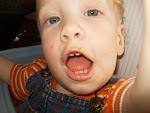I used to bake on Saturdays, baking enough bread for the whole week. We froze it to keep it fresh till we needed it. But freezing destroys some of the vitamins in whole wheat flour, so now I bake bread every other day or so.
I just put today's batch of bread in the oven. Just recently I changed my ever-evolving bread recipe--again. Last week we bought a used grain grinder from friends of ours. My wheat grinder works well, but only for small grains like wheat, rice and barley. I needed something for larger grains like corn and dried beans. (No, beans aren't a grain, but they do go well in bread.)
I still had some dried sweet corn from two summers ago, so when Josiah brought home the new grinder, we tried running that through. It made good cornmeal, but not as fine as I wanted for bread flour. So we ran the grindings through my wheat grinder. It turned out well.
There is a pleasant sense of satisfaction that comes from baking bread using corn you plant, hoe, water, pick, husk, dry, shell and grind into flour yourself. Sort of like the Little Red Hen. Next we're going to try field corn Elijah and Ben gleaned from a nearby corn field. Like Ruth and Naomi.
So here's my current recipe, which is subject to change. If you don't have a grain grinder or a friend with a grain grinder, just use all wheat flour.
Whole Grain Variety Bread
Makes 4 loaves
5 cups very hot tap water
1 cup rolled oats
4 cups whole wheat flour
3 cups variety flour made from any other combination of grains and/or dried beans
2 tablespoons yeast
1 tablespoon salt
1/2 cup oil
1/2 cup honey
3-4 cups or so unbleached flour
Add unbleached flour, 1 or 2 cups at a time, until the dough is stiff enough to knead. Scrape out the dough onto the table. I use a hard plastic scraper to get as much as I can out of the bowl and off the mixing spoon. Then I use flour to rub off the rest. This eliminates a gooey mess in the sink.
Knead in more unbleached flour until the dough is no longer sticky, but still just a little bit tacky. Too much flour makes a drier, more crumbly loaf; not enough makes the dough too sticky to handle well.
Pour about a couple tablespoons of oil in the bottom of the mixing bowl. Put the ball of dough in and turn it around so that all of the dough is coated with oil. Cover loosely with a lid or damp dish towel. Let it rise until it's at least doubled. I usually get busy with other things and forget about it, only to turn around and see the dough lifting the lid and bulging out.
Dump the dough out on the table and punch it flat. If you have little children in your house, let them wash their hands and punch. They love it. They can also help you grease four bread pans with butter. (Oil doesn't coat the pans well enough.) Divide the dough into four pieces and roll them into loaf shapes. When you do this, make sure you're getting rid of any air pockets. Put into pans and put into the cold oven. The oven rack should be one notch lower than middle.
Turn the oven on to 350-375 (depends on how hot your oven is--the temp. should be 375, but my oven heats hotter than the setting, so I set it for 350). Set the timer for 40 minutes. The bread should be done when the timer goes off. You want a loaf that is nicely browned all over.
Turn the bread out onto a wire rack to cool. You can slice thinner slices after it's cool, or you can slice it thicker and enjoy wonderful fresh hot bread right away.
The cry of "Fresh bread!" will bring your children, your neighbours' children and the friends who just pulled in to see the work being done on your house flocking around. Don't be surprised if one or two loaves disappear before your very eyes. Take it as a compliment and start the whole process again the next day.

No comments:
Post a Comment